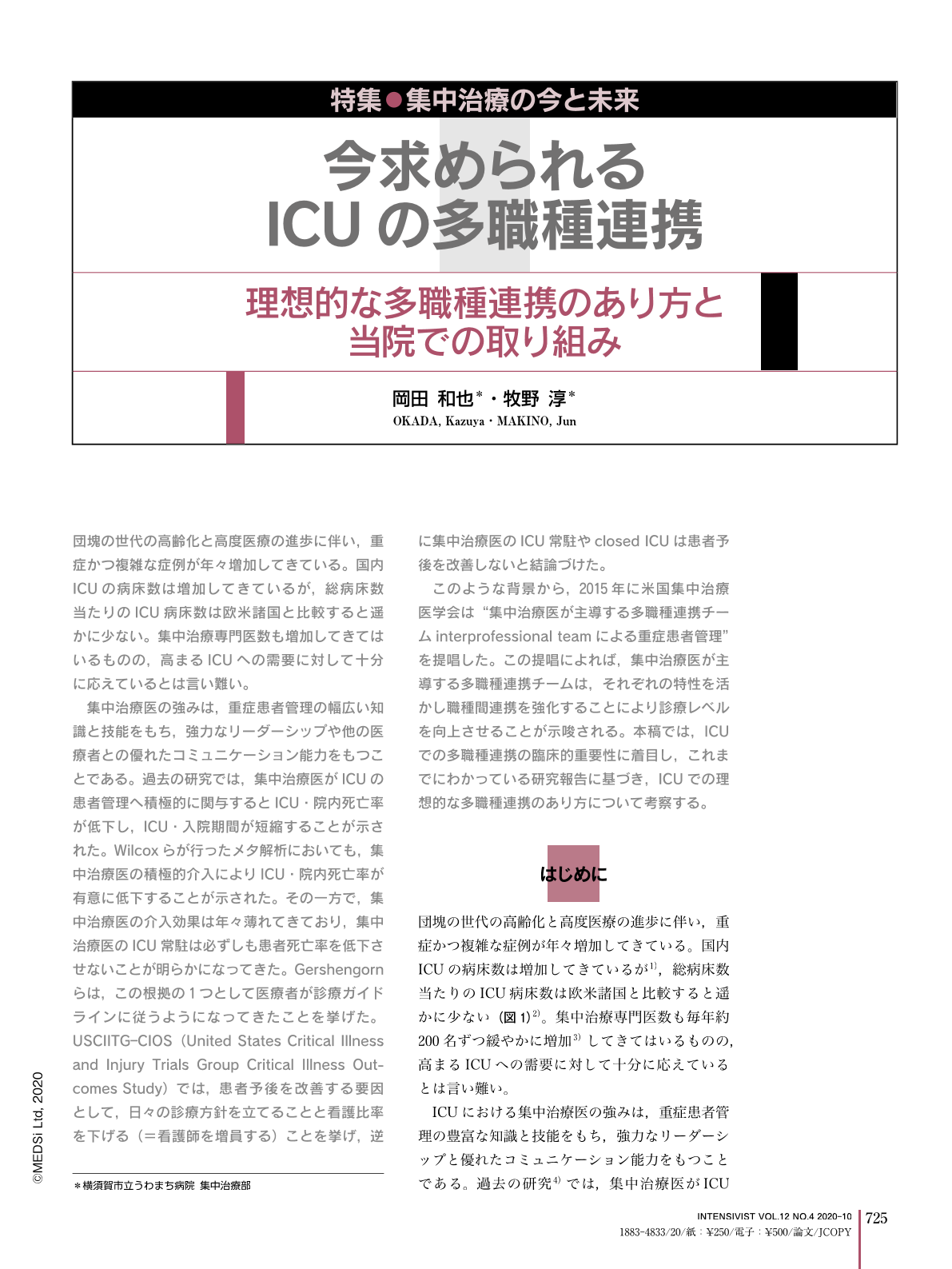Japanese
English
- 有料閲覧
- Abstract 文献概要
- 1ページ目 Look Inside
- 参考文献 Reference
- サイト内被引用 Cited by
団塊の世代の高齢化と高度医療の進歩に伴い,重症かつ複雑な症例が年々増加してきている。国内ICUの病床数は増加してきているが,総病床数当たりのICU病床数は欧米諸国と比較すると遥かに少ない。集中治療専門医数も増加してきてはいるものの,高まるICUへの需要に対して十分に応えているとは言い難い。
集中治療医の強みは,重症患者管理の幅広い知識と技能をもち,強力なリーダーシップや他の医療者との優れたコミュニケーション能力をもつことである。過去の研究では,集中治療医がICUの患者管理へ積極的に関与するとICU・院内死亡率が低下し,ICU・入院期間が短縮することが示された。Wilcoxらが行ったメタ解析においても,集中治療医の積極的介入によりICU・院内死亡率が有意に低下することが示された。その一方で,集中治療医の介入効果は年々薄れてきており,集中治療医のICU常駐は必ずしも患者死亡率を低下させないことが明らかになってきた。Gershengornらは,この根拠の1つとして医療者が診療ガイドラインに従うようになってきたことを挙げた。USCIITG-CIOS(United States Critical Illness and Injury Trials Group Critical Illness Outcomes Study)では,患者予後を改善する要因として,日々の診療方針を立てることと看護比率を下げる(=看護師を増員する)ことを挙げ,逆に集中治療医のICU常駐やclosed ICUは患者予後を改善しないと結論づけた。
このような背景から,2015年に米国集中治療医学会は“集中治療医が主導する多職種連携チームinterprofessional teamによる重症患者管理”を提唱した。この提唱によれば,集中治療医が主導する多職種連携チームは,それぞれの特性を活かし職種間連携を強化することにより診療レベルを向上させることが示唆される。本稿では,ICUでの多職種連携の臨床的重要性に着目し,これまでにわかっている研究報告に基づき,ICUでの理想的な多職種連携のあり方について考察する。
With the aging of “baby boomers” and great progress of modern medicine, the number of severely ill and complicated patients in the Intensive Care Unit (ICU) is increasing. While the number of ICU beds in Japan is increasing, the ratio of ICU beds to total hospital beds remains much less than in Western countries. The number of intensivists has not kept pace with the increased demand for ICU admissions. The strength of being an intensivist is having a wide range of knowledge and skills for managing critically ill patients as well as for exhibiting strong leadership and excellent communication skills with other members of the ICU team. Previous studies have shown that active involvement of intensivists in managing ICU patients reduced ICU/hospital mortality and shortened ICU/hospital lengths of stay. A meta-analysis by Wilcox et al. showed that active involvement of intensivists significantly reduced ICU/hospital mortality. However, the influence of intensivists has diminished over the years, and it has become clear that full-time staffing by intensivists does not necessarily reduce patient mortality. Gershengorn and colleagues pointed out that one of the reasons is that medical practitioners follow medical practice guidelines. In the USCIITG-CIOS(the United States Critical Illness and Injury Trials Group Critical Illness Outcomes Study) study, establishing daily medical treatment policies and lowering the nursing ratio (i.e. increasing the number of nurses) was found to be the most important factor to improve patient prognosis. On the contrary, full-time staffing by intensivists and closed ICUs was not associated with a significant improvement in patient outcomes. Based on these facts, the American Society of Intensive Care Medicine advocated “management of critically ill patients by an interprofessional team led by an intensive care physician” in 2015. This proposal suggests that an interprofessional team led by an intensivist would promote the improvement of clinical management by utilizing the strengths of each team member. This narrative review focuses on the clinical significance of interprofessional collaboration in the ICU, and the ideal style of interprofessional collaboration in the ICU will be discussed based on previous studies.

Copyright © 2020, MEDICAL SCIENCES INTERNATIONAL, LTD. All rights reserved.


